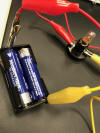PHYSICS 116
Circuitry, Meters, and Ohm’s Law
Equipment:
-
DC power supply (two 2xAA battery holders and 4 AA batteries)
-
Alligator clip wires
- Multimeter
- Lightbulb and holder (any voltage - the ones supplies should be about 6V)
- Capacitor (any)
- 2 different resistors (47, 100, or 200 ohm)
- LED bulb
Experiment:
Determine the resistance of each of the items supplied using the power supply and meters (applying Ohm's Law). Also determine
the resistance of each resistor using the color code on the resistor.
Be sure to graph voltage vs. current over the limited range you can get with
your power supply: You can get at most four data points with four AA batteries,
using 1, 2, 3, or all 4 of the batteries. You can vary the voltage by using one
or two batteries in a battery holder, and by connecting battery holders. Be sure
the connect the positive from one battery holder to the negative of the next
battery holder. If the batteries are connected incorrectly, they will get very
hot and you may melt the holders!
A note about the AA battery holders: Some have wires, and
some do not. You do NOT need wires on any, because you can use your alligator
clip wires to clip directly to the battery connectors, and so although it is a
2xAA battery holder, you can just put in one battery, and connect to the holder
in the appropriate way.



To build a circuit, clip one end of one of the alligator clip wires to your
battery and the other end to one side of your resistor (or capacitor or bulb).
Clip one end of another alligator clip wire to the other side of the resistor (or
capacitor or bulb) and then the other end to free terminal of the battery.
To measure voltage across the resistor, set the multimeter to DC 2V or 20V. Be
sure the red probe of the multimeter is in the port marked "V". Touch the probes
to either side of the resistor. If the reading is negative, you simply have the
positive and negative probes reversed, just switch which side of the resistor
they are touching. To measure current, you will need to disconnect the second
alligator clip wire from the battery and connect it to one probe of the
multimeter. Use a third alligator clip wire to connect from the other multimeter
probe to the battery. If you follow the wire around the circuit, current will
need to flow through the multimeter. Switch the dial to 10A to start. You may
need to adjust the multimeter to the 20 mA setting to get a reading. To do this,
turn the dial and then switch the red probe to the port marked mA.
Note: The maximum voltage you can supply to a resistor is
determined from its power rating. Power used by a resistor is P = IV. The
resistors we are using here are rated at either a maximum of 1/4 Watt or 1/2
Watt. The maximum
voltage that can be supplied to the lightbulb or capacitor is typically listed on the
device.
Note: One
potential problem can lie in shorting the circuit, so that the current does not
run through a resistive element; another potential problem is setting the
voltage of the power supply too high (be sure to always start at zero!) In
these cases a high current will run and could burn out a
component (if it gets hot or starts smoking....) This is something you always want to be sure to avoid.
Safety Note: To avoid electric shock, or burning yourself with a hot
element, you should NOT touch any part of the circuit while the battery is
connected. Unclip one end of the plastic covered alligator clips before changing
the resistor.
Extra. If you feel so smart, try to answer this question thinking about the way
resistive elements use energy in a circuit: If you read a voltage on the 2 V scale
using the meter, and then the 20 V scale, you should get a slightly different reading.
Why do you suppose the reading changes when you change scale?
Write-Up
-
If this is a formal lab (as indicated on the lab syllabus), you have been
instructed as to whether this is an individual or group write-up, or an oral
presentation. If it is a write-up, each person
must submit the lab electronically as a word-processed document in Moodle
before the next lab meeting. If it is a group write-up, you should all
be submitting the same document. For written formal labs, remember to check the "write-up hints" page to be sure
everything is included and check your write-up against the grading rubric.
- If this is an informal lab, work on the results together in your groups,
and be sure to have your complete informal lab in your lab notebook and
checked by the instructor before
you leave.
- Remember to read the next lab and do the pre-lab before you come to lab
next week! You may work on the pre-lab with others, but each person must
submit her or his own work.
Department
of Physics



